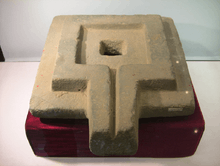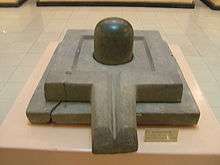Yoni

Yoni (IAST: yoni; Sanskrit: "womb", "uterus", "vagina", "vulva", "abode", or "source") is a stylised representation of female genitalia representing the goddess Shakti in Hinduism.[1][2] Within Shaivism, the sect dedicated to the god Shiva, the yoni symbolises his consort. The male counterpart of the yoni is the lingam. Their union represents the eternal process of creation and regeneration, the union of male and female principles, and all existence. In art and sculpture, this union is represented by a cylinder (lingam, often interpreted as a stylised phallus)[3] resting within a spouted dish (yoni).[2]
In Indian religions

The yoni is considered to be an abstract representation of Shakti and Devi, the creative force that moves through the entire universe.
In Hindu philosophy, according to Tantra, yoni is the origin of life.
In Indian religions according to Vedas and Bhagavad Gita, Yoni is a form of life or a species. There are 8.4 million yonis total with Manushya Yoni (Human form/human species) as one of them. A human (manushya yoni) is obtained on the basis of good karma (deeds) before which a human goes through various forms of yonis (for example, insect, fish, deer, monkey, etc.). Bad karmas will lead one to be born in rakshasa yoni (evil form). The births and rebirths (the cycle of life) of a human happen in various yonis. A human who achieves the enlightenment (Mokshya) breaks the cycle of reincarnation and adjoins Brahma.
Lingam-yoni
In Sanskrit, Yoni means place of birth, source, origin. Lingam means symbol of Shiva. As Shiva is represented as an endless fire, Lingam-yoni denotes origin of an endless fire which created the universe.
The yoni is the creative power of nature and represents the goddess Shakti. The lingam stone represents Shiva, and is usually placed on the yoni. The lingam is the transcendental source of all that exists. The lingam united with the yoni represents the nonduality of immanent reality and transcendental potentiality.
Worship
In Shaktism the yoni is celebrated and worshipped during the Ambubachi Mela, an annual fertility festival held in June, in Assam, India, which celebrates the Earth's menstruation. During Ambubachi, the annual menstruation course of the goddess Kamakhya is worshipped in the Kamakhya Temple. The temple stays closed for three days and then reopens to receive pilgrims and worshippers. It is one of the most important pilgrimage sites in the world, attracting millions of visitors each year, particularly for Ambubachi Mela which draws upwards of 100,000 pilgrims per day during the 4-day festival. Darshan at this temple is performed not by sight as in most temples, but by touch. There is a large cleft, a yoni in the bedrock moistened by water flowing upward from an underground spring, generally covered by cloths and ornate chunris, flowers, and red sindoor powder. Devotees and pilgrims offer items for worship directly to the goddess, then touch her and drink water from the spring. They then receive a tilak and prasad by the attending priest. After completing darshan, devotees light lamps and incense outside the temple. Like other temples, worship is not considered complete until the temple is circumambulated clockwise.
In archaeology
Lingam-yonis have been recovered from the archaeological sites at Harappa and Mohenjo-daro, part of the Indus Valley Civilisation. There is strong evidence to support cultural continuation from the Indus Valley Civilisation (Harappan; Indus-Sarasvati) to Vedic and modern Hindu practices.[4]
Other uses

- Yoni Mudra is a principle in meditation used to reduce distraction during the beginning of yoga practice.
- In the Thai language the medial canthus (the sharp corner of the eye closest to the nose) is referred to as "Yoni Tha" where "Tha" means the eye.
- The yonic symbol has also been used by artists to portray feminism in art.[5]
| Wikimedia Commons has media related to Yoni. |
See also
References
- ↑ Johnson, W.J. (2009). A dictionary of Hinduism (1st ed. ed.). Oxford: Oxford University Press. ISBN 9780191726705. Retrieved 21 October 2016.
- 1 2 "yoni (Hinduism) -- Encyclopedia Britannica". britannica.com. Retrieved 2014-07-28.
- ↑ "Among the Hindus, a phallus, worshipped as a symbol of the god Siva"—entry "Lingam", Oxford English Dictionary 1st edition.
- ↑ Lal, B.B. (2002). The Sarasvati Flows On: The Continuity of Indian Culture. Aryan Books International. ISBN 81-7305-202-6.
- ↑ , Controversial Madonna Painting Opens Magnet HIV Clinic Art Show, Edge on the Net, McCoy, Winnie, Retrieved 30 October 2013.